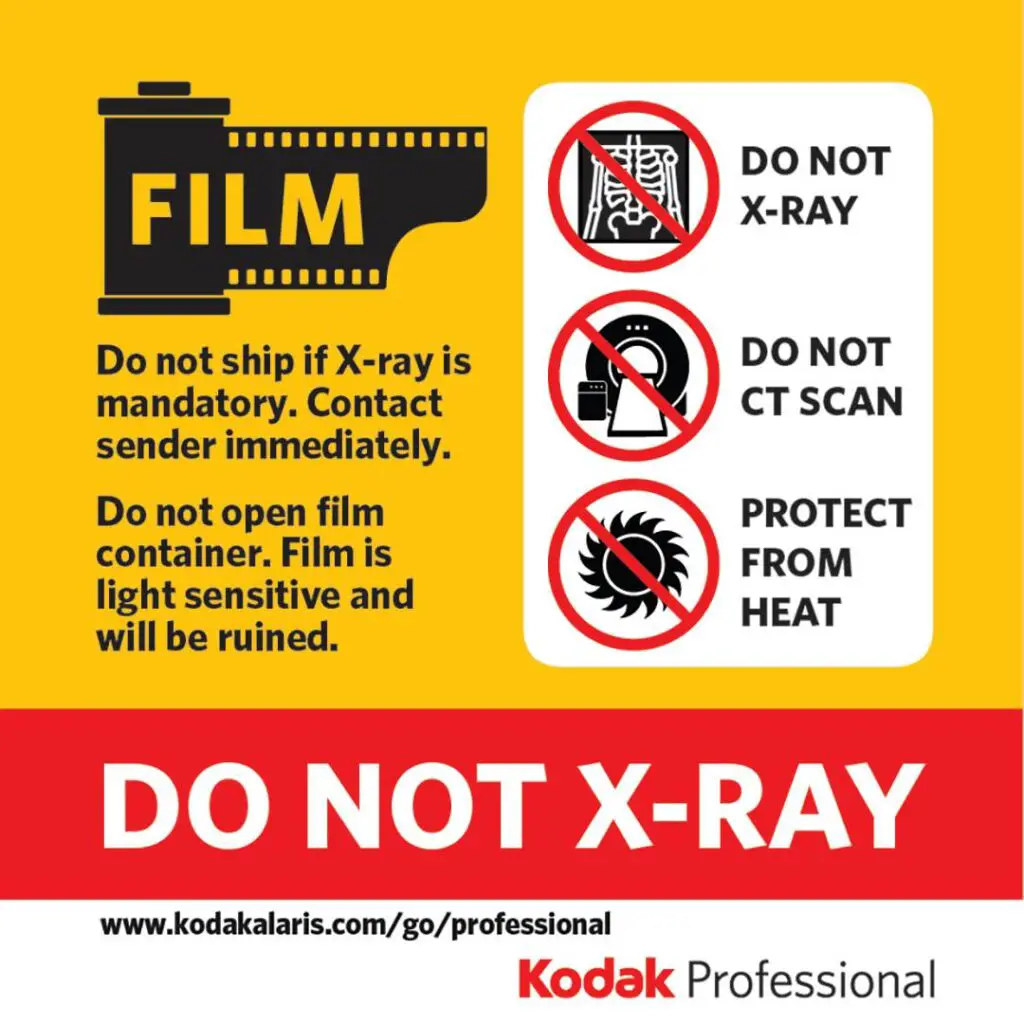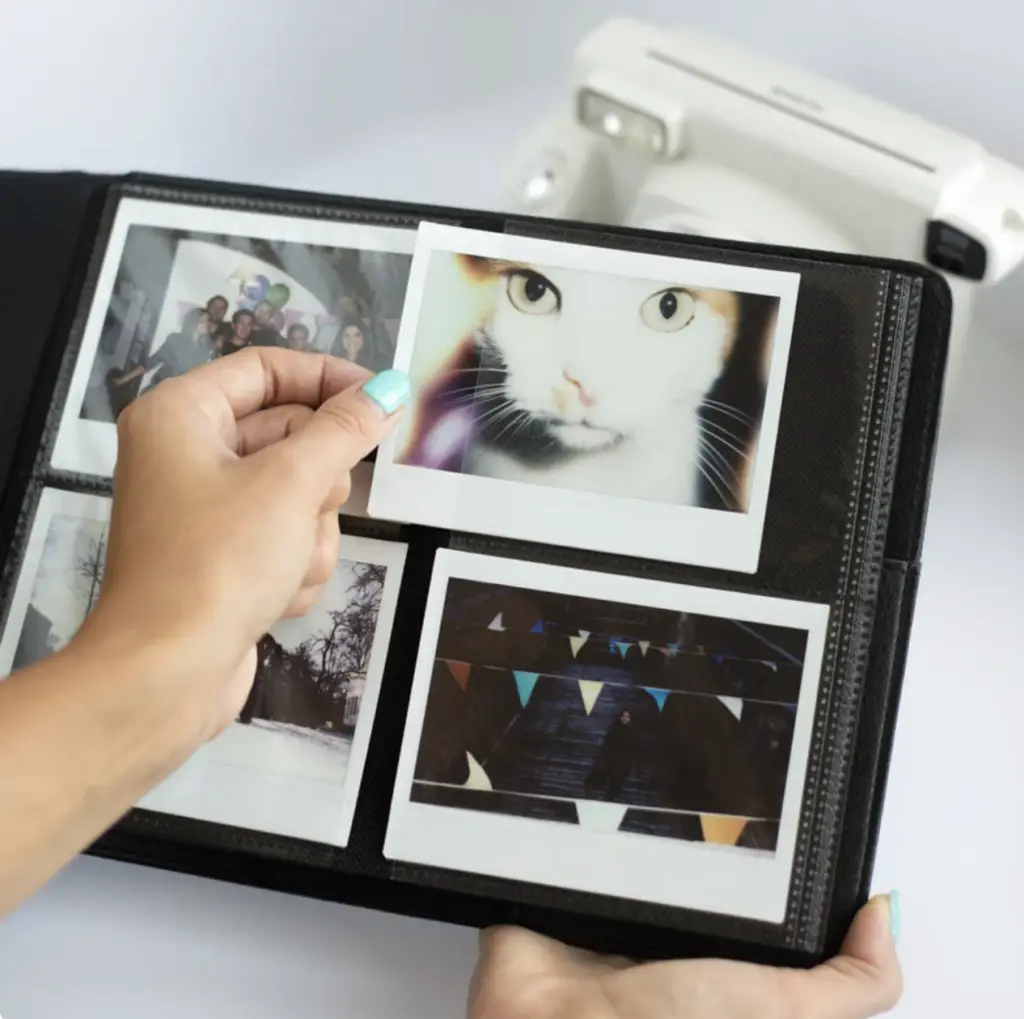Film-based photography has risen in popularity over the last few years due to social media introducing the medium to new audiences. Many want to bring film cameras to document their travels in addition or in place of a digital camera and/or smartphone. With the X-ray scanners used by airport security, many photographers are worried that their film may be ruined.
To safely fly with film, put your unprocessed film and camera in a heavy duty, clear bag, store it in your carry-on luggage, and ask a TSA official to hand check it to avoid being scanned by X-rays. The unprocessed film should also never be stored in checked luggage since checked bags go through even stronger X-rays which will definitely ruin your film. Also, consider applying for TSA Pre-Check when flying with film to avoid much of the hassle.
You can do a few specific things to avoid your film getting destroyed due to airport security measures. Let’s go into more detail about specific film types and other things you should look out for before taking film onto a plane. Keep reading to learn more.
Older X-Ray Scanners vs New CT scanners
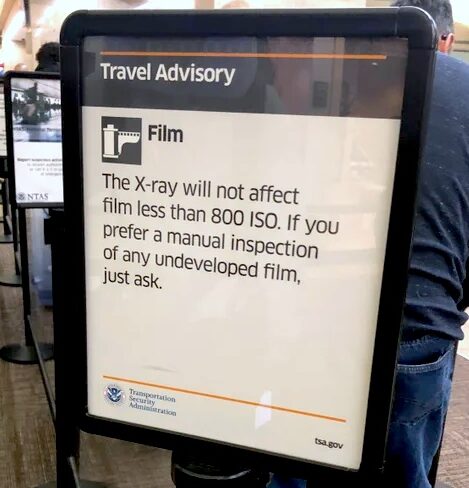
In the past, airport X-ray scanners for security checkpoints were not very strong and allowed for film less than 800 ISO to pass through several times before any damage like fogging to occur. However, scanners used for checked luggage have always been much stronger than those used for carry-on luggage and would damage any kind of film at any ISO rating.
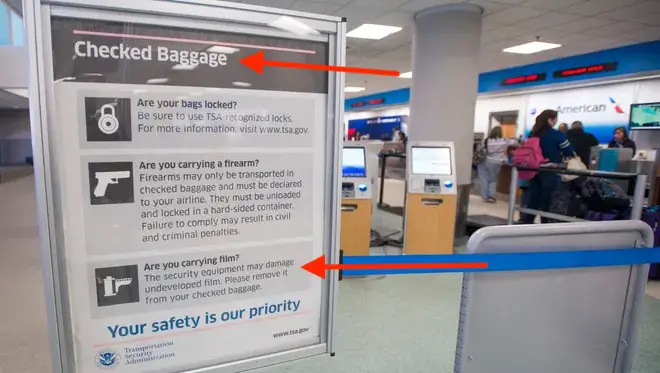
However, since 2020 new airport scanners like the TSA CT (Computed Tomography) scanners (see the image below) has been found to damage any unprocessed film on the first scan. To keep your film from being ruined, put all of your unprocessed and/or new film in a clear, plastic bag and request a hand-check during the security line. Also, keep in mind only new and unprocessed film will be affected, including instant film.
(see the image below) has been found to damage any unprocessed film on the first scan. To keep your film from being ruined, put all of your unprocessed and/or new film in a clear, plastic bag and request a hand-check during the security line. Also, keep in mind only new and unprocessed film will be affected, including instant film.
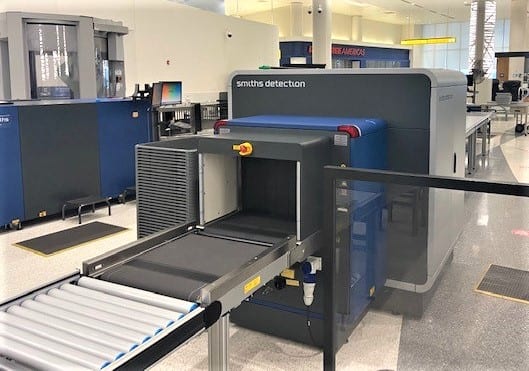
Do the Newest Airport Security Scanners Harm Photographic Film?
Yes, the newest CT airport security scanners will harm photographic film. Photographer Iram Nuri found that 35mm Portra 400 ISO film with only one pass through the new CT scanners before images taken did not noticeably damage his film as long as the film was exposed properly. However, when he sent a roll that already had photos exposed onto it through the CT scanner, the film had a noticeable loss of detail in the shadows. Because of this he highly recommended that you hand-check your film.
found that 35mm Portra 400 ISO film with only one pass through the new CT scanners before images taken did not noticeably damage his film as long as the film was exposed properly. However, when he sent a roll that already had photos exposed onto it through the CT scanner, the film had a noticeable loss of detail in the shadows. Because of this he highly recommended that you hand-check your film.
Also, Kodak did experiments in 2020 where it ran a small batch of 35mm Portra 400 ISO though the CT scanners at John F. Kennedy Airport in New York City 1 – 10 times. Researchers found that just 1 scan showed significant film fogging which lead to lighter blacks and loss of detail in the shadows (similar to photographer Iram Nuri’s findings) and concluded the results would be more significant for higher speed films like 800 – 3200 ISO. For this reason, they “strongly recommend against putting unexposed or exposed but unprocessed film through a CT Scanner.”
in 2020 where it ran a small batch of 35mm Portra 400 ISO though the CT scanners at John F. Kennedy Airport in New York City 1 – 10 times. Researchers found that just 1 scan showed significant film fogging which lead to lighter blacks and loss of detail in the shadows (similar to photographer Iram Nuri’s findings) and concluded the results would be more significant for higher speed films like 800 – 3200 ISO. For this reason, they “strongly recommend against putting unexposed or exposed but unprocessed film through a CT Scanner.”
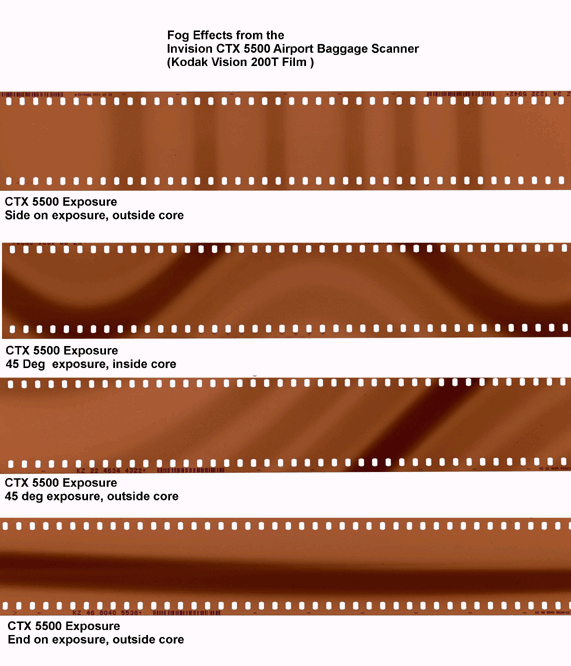



Which Airports Use the New CT Scanners?
According to Kodak , there will soon be CT scanners operational at 145 airports in the US. As of November 2021, the following airports are confirmed to using CT scanners at TSA checkpoints and carry-on baggage screening:
, there will soon be CT scanners operational at 145 airports in the US. As of November 2021, the following airports are confirmed to using CT scanners at TSA checkpoints and carry-on baggage screening:
- Hartsfield-Jackson Atlanta International Airport (ATL)
- Baltimore-Washington International Airport (BWI)
- Chicago O’Hare International Airport (ORD)
- Cincinnati/Northern Kentucky International Airport (CVG)
- Detroit Metropolitan Wayne County Airport (DTW)
- Houston Hobby Airport (HOU)
- Indianapolis International Airport (IND)
- John F. Kennedy International Airport (JFK)
- Logan International Airport (BOS)
- Los Angeles International Airport (LAX)
- Miami International Airport (MIA)
- Oakland International Airport (OAK)
- Phoenix Sky Harbor International Airport (PHX)
- Ronald Reagan Washington National Airport (DCA)
- St. Louis Lambert International Airport (STL)
- Tampa International Airport (TPA)
- Washington-Dulles International Airport (IAD)
- Green Bay–Austin Straubel International Airport (GRB)
- Daytona Beach International Airport (DAB)
- Baton Rouge Metro Airport (BTR)
- Bozeman-Yellowstone International Airport (BZN)
- Billings Logan International Airport (BIL)
General Tips for Taking Film On A Plane
Flying with film may seem stressful but in my experience is easy if you prepare. Follow these general tips to fly confidently with your film:
- Try to identify how many times you’ll have to pass through airport security
- Keep your film and camera loaded with film in your carry-on luggage and not in your checked luggge
- Take your film out of all canisters and wrappers.
- Keep your camera and undeveloped film in your carry-on and keep them in a clear, sturdy plastic bag
- Store your clear bag of film and film camera in an easy to access location of your carry-on luggage
- Arrive 20 – 30 mins early airport security
- Ask for your film camera, new film, and unprocessed film to be hand-checked (including Instant film
 )
)
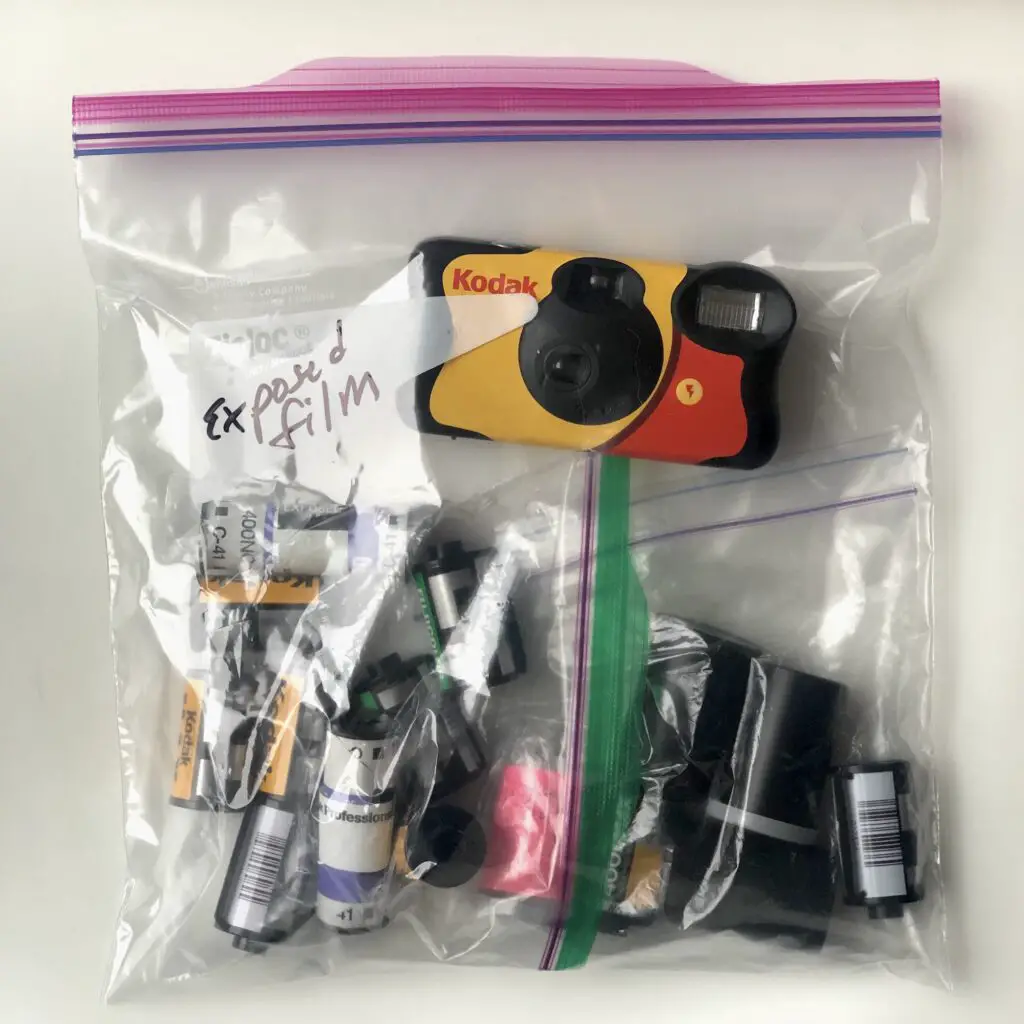
Asking For A Hand Check Varies
It is important to note that asking for a hand check for film at an airport has been reported as varied. One photographer stated that an airport did a “swipe test” for bomb reside on the film canisters checking and testing each canister, which took a long time but he had arrived early and wasn’t a problem. When another photographer asked to get a hand check the agent said that it wouldn’t affect my their film but was adamant saying that the film was rated at a high ISO and didn’t want to damage their film. I myself have had no problem with asking for a hand check with film and film cameras, so I suppose it varies.
stated that an airport did a “swipe test” for bomb reside on the film canisters checking and testing each canister, which took a long time but he had arrived early and wasn’t a problem. When another photographer asked to get a hand check the agent said that it wouldn’t affect my their film but was adamant saying that the film was rated at a high ISO and didn’t want to damage their film. I myself have had no problem with asking for a hand check with film and film cameras, so I suppose it varies.
Lead Lined Bags for Protection
When you are searching about flying with film you may come across lead-lined bag (like this one from Domke) to protect your film in while flying. While this may have worked with the older style X-ray machines, what seems to be happening now is that when an agent comes across this they tent to hit it with higher amounts of X-ray to penetrate the bag , and therefore ruining the film in the process. So use these bags with caution and it is still recommended to just get your film hand checked.
, and therefore ruining the film in the process. So use these bags with caution and it is still recommended to just get your film hand checked.
Mail Your Film To Avoid Possible Film Damage At An Airport
If bringing film through TSA at all sounds a bit risky to you, another option is to send your film in a package to your destination or consider sending your exposed but unprocess film to an online lab for development so you don’t have to worry about it all going through airport security at all.
If you decide to mail your film note that sometimes mailed packages are also x-rayed, so write “Undeveloped Photographic Film. Please Do Not X-Ray” on the outside of the package in large letters. Film mailed in clearly marked processing mailers sold by online film developers like TheDarkroom.com are usually not subjected to x-ray inspection.
are usually not subjected to x-ray inspection.
See this guide on notable places to get film developed online and how much it costs.
and how much it costs.
Tips For Flying with 35mm and Medium Format Film
Roll film, like color or black & white 35mm film and Medium Format film, are most likely what you will be taking on plane if you are traveling with film at all. The good news is that both 35mm and medium format film can go through airport security, but you will need to exercise precaution.
can go through airport security, but you will need to exercise precaution.
Most older X-ray machines found in airports will not cause damage to unexposed film rated up to ISO 800 unless the film is subjected to repeated passes. Though it is also not recommended to allow film of higher speeds, like 3200 ISO, to pass through the scanners. Because of this the TSA recommends  that you keep your color and black & white 35mm and Medium Format film in your carry-on luggage and ask for a handcheck.
that you keep your color and black & white 35mm and Medium Format film in your carry-on luggage and ask for a handcheck.


However, be aware that the new airport scanners like the TSA CT scanners (like the one above) and scanners that screen checked bags give off high doses of X-rays that will damage unprocessed film on the first scan. To keep your film from being ruined, put all of your unprocessed or new film in a clear, plastic bag and request a hand-check.
(like the one above) and scanners that screen checked bags give off high doses of X-rays that will damage unprocessed film on the first scan. To keep your film from being ruined, put all of your unprocessed or new film in a clear, plastic bag and request a hand-check.
In the images below you can see how airport scanners damaged the film and what it looks like. Notice the light and dark bands on the negatives as well as the fogging on the portrait.




See this website by Kodak for examples of film damaged by x-ray scanners and what to look for.
and what to look for.
How To Keep Your 35mm and Medium Format Film Safe While Flying
The best method to keep your unprocessed film safe to ask security to hand-check your camera and film if possible, so that it is not exposed to the x-rays at all. Put your unprocessed film and camera into a clear plastic bag (I recommend a sturdy Ziplock gallon bag like this one on Amazon.com) and ask the attendant for it to be checked by hand.

Follow these steps for confidently flying with your 35mm and Medium Format film:
- Try to identify how many times you’ll have to pass through airport security
- Keep your film and camera in your carry-on luggage and not in your checked luggage
- Take all of your film out of the canisters and wrappers
- Keep your film and camera in a clear, plastic bag
- Store your transparent bag of unprocessed film and film camera in an easy to access location of your carry-on luggage
- Arrive 20 – 30 mins early airport security
- Ask for your unprocessed film and film camera to be hand-checked
Tips For Flying with Disposable Cameras
Disposable cameras can go through security but, just like with roll film, there needs to be some caution.
Most older X-ray machines found in airports will not cause damage to unexposed film in your disposable film camera rated up to ISO 800 unless the film is subjected to repeated passes. Though it is also not recommended to allow film of higher speeds, like 3200 ISO, to pass through the scanners.


However, be aware that the new airport scanners like the TSA CT scanners (like the one above) and scanners that scan checked bags give off high doses of X-rays that will damage unprocessed film on the first scan. To keep your film from being ruined, put all of your unprocessed or new film in a clear, plastic bag and request a hand-check.
(like the one above) and scanners that scan checked bags give off high doses of X-rays that will damage unprocessed film on the first scan. To keep your film from being ruined, put all of your unprocessed or new film in a clear, plastic bag and request a hand-check.
In the images below you can see how airport scanners damaged the film and what it looks like. Notice the light and dark bands on the negatives as well as the fogging on the portrait.




See this website by Kodak for examples of film damaged by x-ray scanners and what to look for.
and what to look for.
How To Keep Disposable Cameras Safe While Flying
The best method to keep your disposable camera safe is to ask security to hand-check your camera and film, so that it won’t be exposed to X-rays at all. Put your unprocessed disposable camera(s) into a clear, sturdy, plastic bag (I recommend a sturdy Ziplock gallon bag like this one on Amazon.com) and ask the TSA agent for it to be checked by hand.

Follow these steps for confidently flying with your disposable cameras:
- Try to identify how many times you’ll have to pass through airport security
- Keep your disposable camera(s) in your carry-on luggage and not in your checked luggage
- Take all of your cameras out of the wrappers.
- Keep your camera(s) in a clear, plastic bag
- Store your transparent bag of disposable camera(s) in an easy to access location of your carry-on luggage
- Arrive 20 – 30 mins early airport security
- Ask for your disposable camera(s) to be hand-checked
Another tip for flying with disposable cameras is consider removing the film canister from your camera when you finish the roll reduce the size of your film bag and allow you to carry more. See this guide on how to remove film from a disposable camera.
from a disposable camera.
Tips For Flying with Instant Film
The good news is that you can fly with any instant film like Polaroid or Fujifilm Instax
or Fujifilm Instax  but you will want to have your film checked by hand and never allow it to go through any airport security scanners – old or new. However, the good news is that instant film that have been ejected from an instant camera are unaffected by X-rays!
but you will want to have your film checked by hand and never allow it to go through any airport security scanners – old or new. However, the good news is that instant film that have been ejected from an instant camera are unaffected by X-rays!
How Do You Travel with Instant Film?
Undeveloped Instant film, like Polaroid and instax film , will be ruined by X-rays at the airport (or other places) because it is more sensitive to X-rays than roll film. he best way to protect instant film from being ruined by x-rays is to carry your unwrapped instant film (and camera if it has film in it as well) in a sturdy clear plastic bag (like this one) and ask to have it handchecked when going through baggage check.
, will be ruined by X-rays at the airport (or other places) because it is more sensitive to X-rays than roll film. he best way to protect instant film from being ruined by x-rays is to carry your unwrapped instant film (and camera if it has film in it as well) in a sturdy clear plastic bag (like this one) and ask to have it handchecked when going through baggage check.
Always ask for it be hand checked but keep in mind the attendant will most likely open up any of the foil pouches that instant film comes in so if you go ahead and open it beforehand to save time.
Tips for taking your Instax camera on an plane are:
- Try to identify how many times you’ll have to pass through airport security
- If possible, obtain a lead-lined bag (like this one from Domke)
- Keep your instant film and instant camera in your carry-on luggage and not in your checked luggage
- Take all of your instant film out of the silver wrappers.
- Keep your instant film and camera in a clear, sturdy plastic bag
- Store your transparent bag of instant film and your instant camera in an easy to access location of your carry-on luggage
- Arrive 20 – 30 mins early airport security
- Ask for your instant camera loaded with film and undeveloped instant film to be hand-checked
Do X-rays Ruin Instant Film?
Yes, X-rays will create light and dark bands on your image, fog your undeveloped Instant film, and produce dark and muddy shadows. Notice the images below where the x-ray scan created fog on the image and the x-ray created white and dark bands of color.
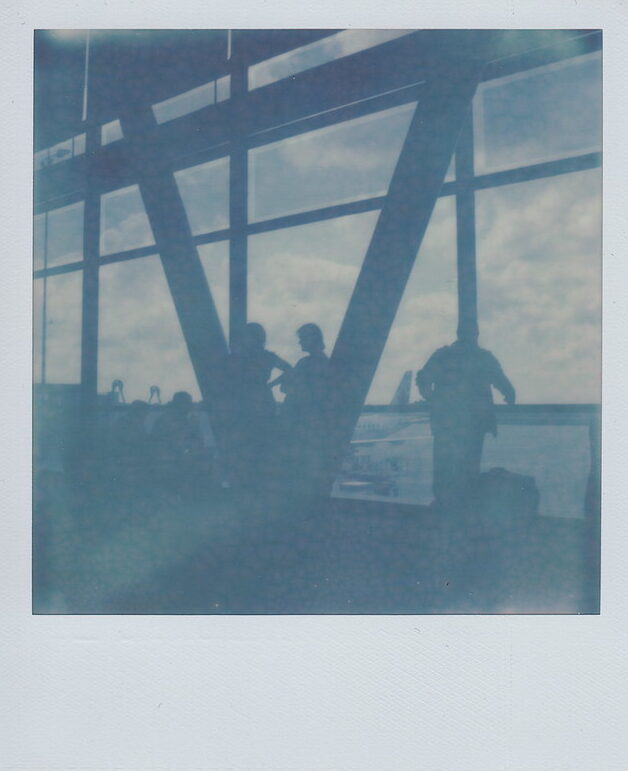

Because of this it is best to keep your camera with carry-on luggage, store your camera loaded with film and undeveloped film in a clear plastic bag, and politely ask for a hand-check went going through security.
However, the good news is exposed and developed instax film won’t be damaged at all going through airport scanners!
won’t be damaged at all going through airport scanners!
Consider TSA Pre-Check When Flying With Film
One way to make the airport experience go smoother when flying with film is to consider signing up for TSA Pre-Check. While it can be expensive if you don’t fly often ($85 for five years and $70 to renew), it can save you a lot of hassle, time, and stress.
The application process for TSA Pre-Check be done online in under 5 minutes, then schedule a 10-minute appointment at an enrollment center that includes a background check and fingerprinting, then get notification of your approval in around 3 – 5 days (can take up to 90 days) and you can check your status online
that includes a background check and fingerprinting, then get notification of your approval in around 3 – 5 days (can take up to 90 days) and you can check your status online .
.
With a TSA Pre-Check boarding pass, you get a dedicated line at airport security which tends to move faster and you get special privileges such as:
- Keeping on your shoes, belt, and light jackets
- Keeping your electronics (like cameras) in your carry-on
- Easier to hand check film (might not have to even remove it from your carry-on)
- Keeping your toiletries in your carry-on
- Bypassing the body scanner
The downside other than the price (which in my mind is worth it even if you only travel once a year) is that not all airports or airlines have TSA Pre-Check, but you can see a full list by visiting: https://www.tsa.gov/precheck/map
It’s possible that you can get TSA Pre-Check for free if you get randomly assigned (more likely if you are a senior citizen (75 or older), military benefits, you redeem miles or points, be 12 or under, have a certain credit card, or if you are flying business or first class.
However, you may not want to sign up for TSA Pre-Check if you already have Global Entry since you get Pre-Check along with Global Entry and it’s only $15 more than TSA Pre-Check at $100 for five years even though the application process is more stringent. Check out this article about TSA Pre-Check for more information.
for more information.
Find out more about TSA Pre-Check by visiting: https://www.tsa.gov/precheck .
.
Digital Cameras and Security Scanners
It is important to remember that it is completely safe for digital cameras to go through the older and new CT style of X-ray machines. There is a slight chance that flash memory (like SD cards) can be corrupted due to amount and length of exposure but this has never happened to me in all the time I’ve been flying with digital cameras (13 countries between 2016 – 2019).
Flying with Spare Rechargeable Batteries
One reason you may want to keep your digital camera in carry-on luggage is because it is fragile and to keep it safe. According to the FAA , your camera and spare rechargeable batteries for your camera need to be in carry-on because they may explode if they are put in checked baggage. Spare rechargeable batteries are limited limited to a rating of 100 watt hours (Wh) per battery with no limit on the number.
, your camera and spare rechargeable batteries for your camera need to be in carry-on because they may explode if they are put in checked baggage. Spare rechargeable batteries are limited limited to a rating of 100 watt hours (Wh) per battery with no limit on the number.
Most Newer lithium ion rechargeable batteries have the Wh rating marked on them. If not, you can calculate the Watt Hour (Wh) by multiplying the battery voltage by the Amp hours (Ah).

